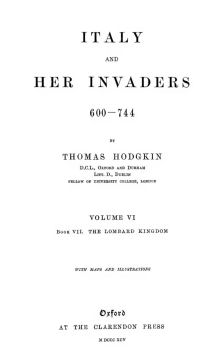 |
Italy and her invaders, 600-744 Volume VI. Book VII. The Lombard kingdom
by Thomas Hodgkin
At The Clarendon Press, Oxford 1895
Scans of vols. II, III, and VI in .pdf format (60 Mb) from www.b-ok.xyz |
 |
Italy and her invaders, 600-744 Volume VI. Book VII. The Lombard kingdom
by Thomas Hodgkin
At The Clarendon Press, Oxford 1895
Scans of vols. II, III, and VI in .pdf format (60 Mb) from www.b-ok.xyz |
CHAPTER VI. GRIMWALD AND CONSTANS.
Romwald, Duke of Benevento: colony of Bulgarians 284
. . .
The Bulgarians in the duchy of Benevento.
At Benevento, young Romwald seems to have remained ever in cordial love and loyalty to his father, and we may conjecture that the kingdom and the duchy were more closely confederate together during the reign of Grimwald than at any other period of their joint existence. The chief event of the young duke’s reign seems to have been the arrival of a colony
284
of Bulgarians, in Italy under their duke Alzeco, who, ‘with all the army of his duchy,’ came to King Grimwald, and promised faithful service on condition of being allowed to reside in his land. Him Grimwald passed on to his son, desiring the latter to provide suitable habitations for him and his people. They were heartily welcomed by the young duke, who assigned to them for their residence a spacious region to the north of his capital, which had lain desert until that time, and which included the cities of Bovianum, Sepinum, and Aesernia. The fact that this broad reach of territory (situated, it is true, among the highlands of Samnium) should have remained desert till these Bulgarians from the Danube country came to occupy it, tells its own sad story of the desolation of Italy. The Bulgarian Alzeco coming thus into the territory of Duke Romwald, in a relation which in a later century would have been described as that of vassalage, had to forego the title of duke which he had hitherto borne, and be content with that of gastald, a title which, as we shall hereafter see, expressed more of personal dependence on the sovereign than the title of duke. Even down to the days of Paulus, that is, for a full century after the settlement, though the descendants of these settlers had learned the Latin tongue, the rude Bulgarian speech was still heard in these cities and villages round the skirts of Monte Matese [1].
1. See Bury’s History of the Later Roman Empire, II. 333, for some interesting remarks on this Bulgarian migration. The words of Paulus are remarkable :
‘Per haec tempora Vulgarum dux Alzeco nomine, incertum quam ob causam, a sua gente digressus, Italiam pacifice introiens, cum omni sui ducatus exercitu ad regem Grimwald venit, ei se serviturum atque in ejus patria habitaturum promittens. Quem ille ad Romualdum filium Beneventum dirigens, ut ei cum suo populo loca ad habitandum concedere deberet praecepit. Quos Romualdus gratanter excipiens, eisdem spatiosa ad habitandum loca quae usque ad illud tempus deserta erant, contribuit, scilicet Sepinum, Bovianum et Iserniam (sic) et alias cum suis territoriis civitates ipsumque Alzeconem, mutato dignitatis nomine de duce gastaldium vocitari praecepit. Qui usque hodie in his ut diximus locis habitantes, quamquam et Latine loquantur, linguae tamen propriae usum minime amiserunt.’
It seems probable that this settlement of the Bulgarians was partly a measure of precaution against attack from Rome or Naples. All the three towns named are on the back-way leading from the Via Latina across the mountains to Benevento.